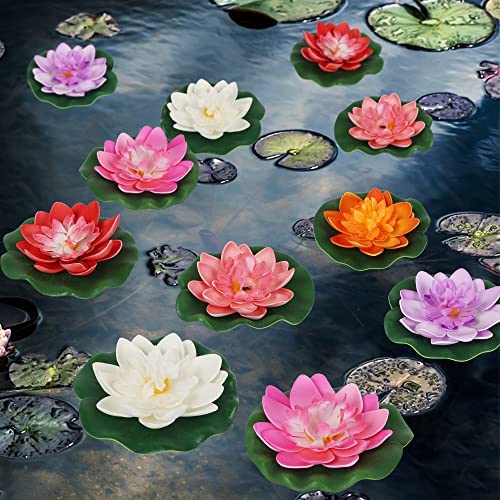Before I tell you about the plant that is the most beautiful and well-known in many religions, if you are looking for the meaning of the lotus flower in Buddhism, let me first explain what it is. What does the lotus blossom represent in Buddhism here?
Table of Contents
What does a lotus flower represent in Buddhism?
Buddhism: Lotus Flower Meaning – According to legend, lotuses bloomed everywhere the Buddha walked. The significance of the lotus blossom in Buddhism includes purity, awakening to one’s spiritual path, devotion, faith, and commitment. In Buddhism, the lotus blossom is significant. As the lotus flower blooms above the mud water, it detaches itself from the suffering, which is why it is connected to purity of mind and soul. The flower also symbolizes non-attachment because lotus plants’ roots remain intact in the mud.
The Lotus Sutra, one of the most significant and revered writings in Buddhist traditions, is where the history of the lotus flower is found. The reason it is also taught in schools is that each stage of lotus bloom growth represents a step along the road to enlightenment.
Mahayana Buddhism holds that when the lotus flower buds fully open, it signifies that the individual is enlightened. While the partially opened buds’ secret centers hint at potential enlightenment, there is still time. Additionally, if flower buds are completely closed, it indicates the period of time prior to enlightenment.
Buddha compares himself to the lotus flower in the Buddhist text known as the Anguttara Nikaya because, as how the lotus flower blooms above the murky water with clean, unstained petals, so too does he emerge from the physical world without any impurities. Buddhists also hold that the lotus flower, which rises above the mud, symbolizes the purity of the body, mind, and voice, and that the flower, which is free from attachments and wants of the material world, signifies freedom from attachments.
4 types of lotus in Buddhism
Buddhism uses a variety of lotus flowers with various symbolic connotations.
A white lotus symbolizes a state of mind that has been cleansed of all negativity.
A pink lotus stands for all the Buddhas who have come before him, their history, and Buddha himself.
A red lotus represents compassion or an awareness of another person’s suffering or grief. Additionally, it discusses the purity of the heart and soul.
The enlightenment of All Buddha is represented by a gold lotus.
A purple lotus stands for self-awakening, knowledge, convictions, and feelings.
The Buddhist holds that human behavior needs to be controlled in order to preserve the universe’s inherent order. According to how much a person can grasp, there are four different levels of dhamma, and the Buddha compared these four levels:
Buddha Holding Lotus Flower Meaning
Avalokitevara, also known as Buddha Amitabha, is an earthly entity who travels the path of the Buddha in order to become enlightened. But in doing so, he turns into a rescuer and offers defense against the negative aspects of society. Padmapani is one of 108 avatars that he has. The Buddha known as Padmapani is the one who is carrying a lotus flower in his palm. A monk by the name of Dharmakara made a promise to the populace that after he attained Buddhahood, those who adhered to and believed in him would be reincarnated in his place, which would be filled with happiness and something devoid of sadness. Up until they ultimately arrive to the road of enlightenment, they will bask in the happiness. Dharmakara, who kept his word, evolved into Avalokitesvara, also referred to as Buddha Amitabha.
Only the two bodhisattvas—the one representing Buddha’s past lives and the one representing Buddha’s future lives, also known as Maitreya—are still believed in by practitioners of actual Buddhism today. Avalokitevara is one of many bodhisattvas who exist.
First, we need to comprehend the meanings of the words “ava” (which means down), “lokita” (which means to observe), and “esvara” (which means God himself). This results in “God who observes or gazes down to the world” when I combine these.
Lotus flower Buddhism Facts
About Buddha Lotus Flower Meaning
Buddhism is one of the world’s and Asia’s fastest-growing religions. It was built on the teachings of Gautama Buddha and has its roots in ancient India. Buddhists in this faith hold that one can go on the road of spiritual life, which involves meditation, calmness, and good behavior, to gain enlightenment or to get free from all the pain from human existence.
Between the sixth and fourth centuries BCE, Buddha lived in the northern region of India. Sanskrit and Pali, two ancient languages, were used to write the majority of ancient Buddhist books and scripture. Sanskrit’s word for “dharma” is related to Pali’s term for “dhamma.”
About Lotus Flower
Nelumbo, which is its scientific name, is one of the well-known flowers found in South Asia. They swim in water Typically, plants grow in water, with the flowers growing above the surface and the leaves floating on the water’s surface. They must be grown in a sturdy container without drainage holes. While the entire stem reaches the water’s surface and gradually adds more leaves, the lower end has dirt that nourishes the roots. The lotus flower is known for its astonishing ability to bloom during the day and close its petals at night due to a lack of light. For a healthy growth, these plants need a lot of water and fertilizer. Do not mix them with the water lilies that, according to a particular mechanism, bloom at night. Lotus, on the other hand, only blooms when the sun is directly overhead and it receives sunlight. In addition to being helpful plants for the garden, lotuses are also employed in the production of various commercial goods.
Learn how to properly care for lotus plants.
Wrap Up
Christian Meaning of the Lotus Flower: Strength (Does It Means)



